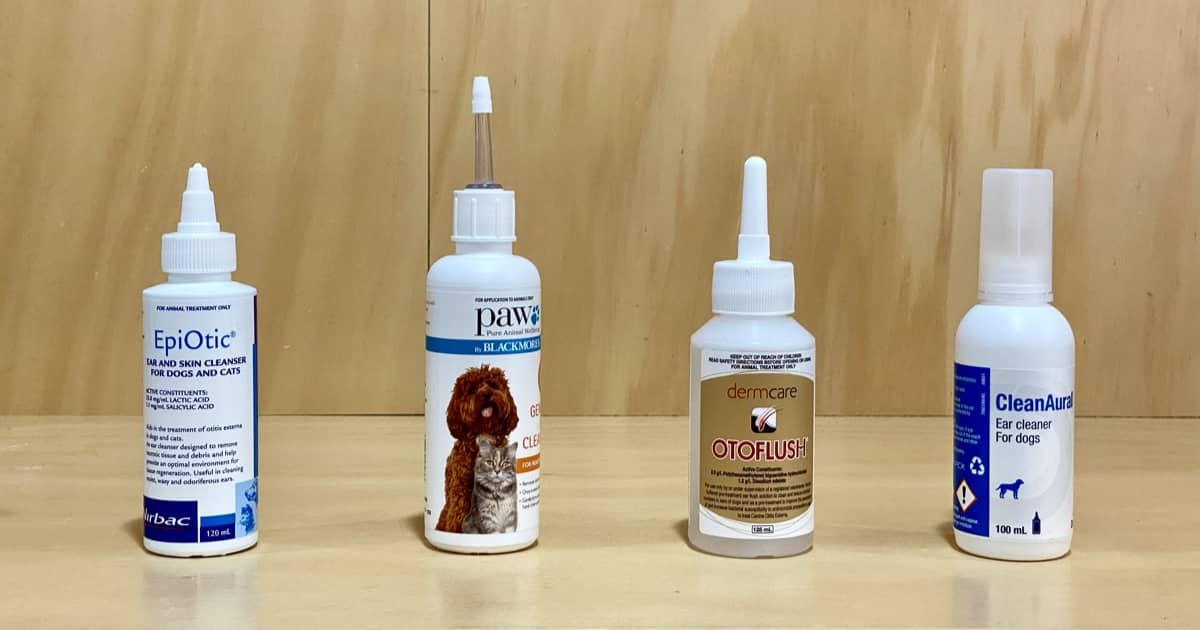Updated October 17, 2021
All vets have their favourite ear cleaners. However, what does the evidence say?
Unfortunately, it’s mostly based on products found in the UK and USA, but we can still use it to make some general rules for Australian dogs.
I can find three recent papers, two of which compare a number of products. Their results are summarised in the table below.
| Ear Cleaner | Yeast Activity1 | Yeast Activity2 | Bacterial Activity2* |
|---|---|---|---|
| CleanAural Dog® | Excellent | 1/32 Dilution | 1/32 & 1/8 |
| Epi‐Otic® Advanced | Excellent | 1/8 Dilution | 1/2 & 1/8 |
| MalAcetic Aural® | Excellent | 1/4 Dilution | 1/2 & 1/2 |
| Sancerum® | Excellent | 1/8 Dilution | 1/16 & 1/16 |
| TrizUltra® + Keto | Excellent | n/a | n/a |
| Otodine® | Moderate | n/a | n/a |
| Surosolve® | Moderate | n/a | n/a |
| Otoclean® | Variable | 1/8 Dilution | 1/4 & 1/4 |
| Cerumaural® | None | n/a | n/a |
| Triz Plus® | n/a | 1/8 Dilution | 1/2 & 1/16 |
Paper 1 used the cleaner in dogs themselves, so is potentially more valid than paper 2 where they looked at activity in the lab at different dilutions. For paper 2, a cleaner that still works at a 1/32 dilution is better than one that stops at 1/16 or 1/2.
Only the first two are available in Australia, but we have other products not found on this list.
The Best Ear Cleaners In Australia
A further paper3 compares Epi-Otic Advanced with the cleaner found in Australia (Epi-Otic). Note that both were equally uncomfortable in 38% of dogs, which is why I don’t use acidic cleaners when infection is present. Pleasingly, however, it found that there is very little difference in efficacy.
This is gratifying as I feel that Epi-Otic is very good for the prevention of yeast infections.
I use PAW Gentle Cleaner primarily for wax accumulation without infection.
Note that Epi-Otic’s main weakness is its activity against Staph. And in fact, you can see a good demonstration of this here. For these infections in Australia, I have used Otoflush.
Until doing this comparison I did not realise I could also buy CleanAural in Australia. I found it being sold at a local supplier, then used it for 1 month only to find it was discontinued and I could no longer get it! Back to Otoflush for me.
The four ear cleaners in bold are pictured above.
How To Clean Ears At Home Naturally
What about these commonly recommended ear cleaners?
- alcohol
- olive oil
- hibiscrub (chlorhexidine)
- vinegar
- hydrogen peroxide
None of these are likely to work well, especially in the presence of infection. All are also likely to cause damage to hearing if the ear drum is ruptured. Some could be very painful.
I have included a recipe for an apple cider vinegar ear flush here, but I honestly would not use it unless no other options are possible. As you can see from the table above, pH is not the only factor in the efficacy of ear cleaners.
Now you’ve chosen your cleaner, all you need now is to know how to use it! So next, read my seven quick and easy steps to clean your dog’s ears.
Have something to add? Comments (if open) will appear within 24 hours.
By Andrew Spanner BVSc(Hons) MVetStud, a vet in Adelaide, Australia. Meet his team here.
Sources
- Mason, C. L., Steen, S. I., Paterson, S., & Cripps, P. J. (2013). Study to assess in vitro antimicrobial activity of nine ear cleaners against 50 Malassezia pachydermatis isolates. Veterinary dermatology, 24(3), 362-e81.
- Swinney, A., Fazakerley, J., McEwan, N., & Nuttall, T. (2008). Comparative in vitro antimicrobial efficacy of commercial ear cleaners. Veterinary dermatology, 19(6), 373-379.
- Rème, C. A., Pin, D., Collinot, C., Cadiergues, M. C., Joyce, J. A., & Fontaine, J. (2006). The efficacy of an antiseptic and microbial anti-adhesive ear cleanser in dogs with otitis externa. Veterinary Therapeutics, 7(1), 15.

